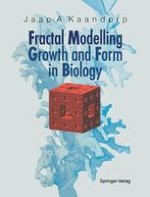1994 | OriginalPaper | Chapter
2D Models of Growth Forms
Author : Jaap A. Kaandorp
Published in: Fractal Modelling
Publisher: Springer Berlin Heidelberg
Included in: Professional Book Archive
Activate our intelligent search to find suitable subject content or patents.
Select sections of text to find matching patents with Artificial Intelligence. powered by
Select sections of text to find additional relevant content using AI-assisted search. powered by
This chapter discusses how a system of rules can be created, as shown in the section on the ramifying objects, suitable for the simulation of the growth process of various sessile marine organisms, for example sponges (Porifera) and corals (Scleractinia). A crucial difference with the example of the ramifying objects is that each modelling step is supposed to have a biological significance. An important reason to use sponges and corals as subjects of a case-study is that these organisms exhibit a relatively simple growth process, which makes it comparatively easy to design geometric production rules to simulate growth processes. Although the marine sessile organisms belong to many very different taxonomic groups, it is possible to distinguish several types of corresponding growth processes within these groups, in which a similar architecture emerges. First almost all groups belong to the large group of modular organisms. In this group there is a subset of organisms which are formed by one type of growth process, which will be discussed in particular in the next sections. This growth process can be found within sponges, stony corals and many other marine sessile organisms and will be indicated as radiate accretive growth. Modular growth and radiate accretive growth are the first subjects in this chapter, followed by a 2D model of radiate accretive growth.
